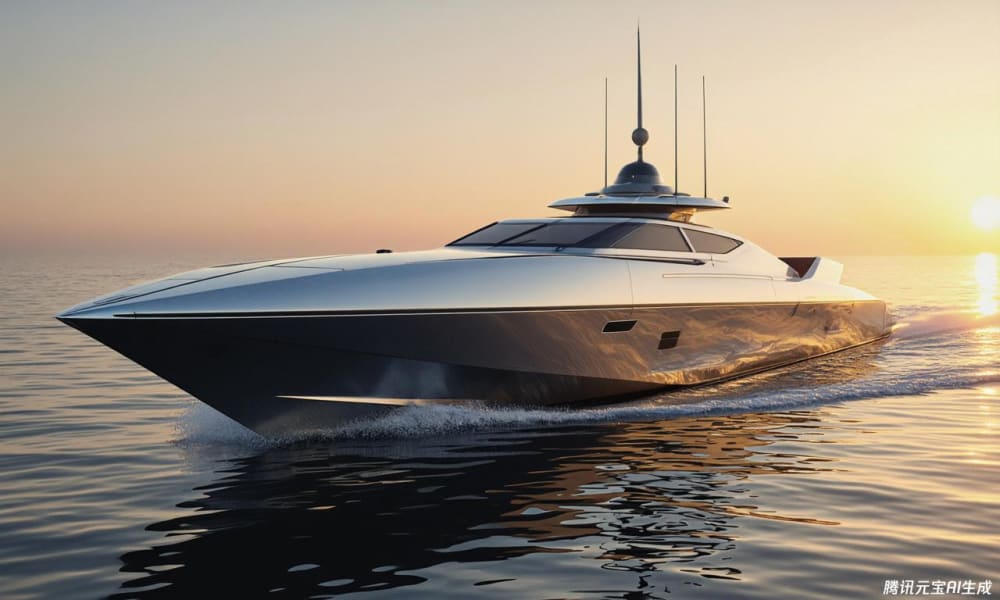The Negative Embodied Carbon Autonomous Unmanned Surface Vehicle (NEC-USV) is a pioneering maritime platform designed to achieve a net-negative carbon footprint while delivering advanced capabilities for maritime security and environmental monitoring. Constructed with carbon fiber derived from captured and recycled CO2 and powered by synthetic e-fuel combustion, the NEC-USV integrates sustainable materials and propulsion with AI-driven autonomy. It supports missions such as surveillance, counter-piracy, illegal fishing detection, and environmental monitoring in challenging maritime environments.
How It Works
The NEC-USV’s hull is made from carbon fiber produced using captured CO2 and recycled carbon sources, significantly reducing embodied carbon compared to conventional materials like aluminum or fiberglass. Propulsion is provided by a synthetic e-fuel combustion engine, utilizing carbon-neutral fuels derived from atmospheric CO2, ensuring low-emission operation over extended missions. The USV is equipped with an AI-driven control system, integrating radar, sonar, and electro-optical/infrared (EO/IR) sensors for autonomous navigation, obstacle avoidance, and real-time data processing. Secure satellite and 5G communication links enable remote data transmission to shore-based command centers. An onboard CO2 capture system, using solid sorbent technology, sequesters atmospheric carbon during operation, contributing to its negative carbon footprint.
Innovation
The NEC-USV advances sustainable maritime technology by combining CO2-derived carbon fiber with e-fuel propulsion and active CO2 capture. Unlike traditional USVs, which rely on high-carbon materials and fossil fuels, the NEC-USV achieves net-negative embodied carbon, aligning with global decarbonization goals. Its modular sensor payload supports versatile mission profiles, from maritime security (e.g., EEZ surveillance, counter-piracy) to environmental tasks (e.g., oil spill monitoring). The integration of solid sorbent CO2 capture technology is a novel feature, enabling the USV to actively reduce atmospheric carbon while performing operational tasks.
Feasibility/Manufacturability
The NEC-USV leverages scalable carbon fiber production techniques using CO2-derived and recycled sources, supported by partnerships with advanced material manufacturers. Synthetic e-fuel combustion engines are commercially viable, with global production capacity expanding rapidly. The USV’s modular design simplifies assembly and maintenance, utilizing existing shipyard infrastructure. The solid sorbent CO2 capture system, based on proven industrial applications, is adaptable for maritime use with minimal development. Production costs are competitive with high-end USVs due to reduced lifecycle emissions and fuel efficiency, making large-scale manufacturing feasible.
Marketability
The NEC-USV meets the rising demand for sustainable maritime solutions, driven by regulations like the IMO’s 2050 net-zero goals. It addresses critical needs in monitoring Exclusive Economic Zones (EEZs), combating illegal fishing (a $23 billion annual global loss), supporting search and rescue, and tracking environmental threats like oil spills. Target markets include navies, coast guards, environmental agencies, and commercial operators in shipping and offshore energy. Its carbon-negative profile and dual-use capability for security and environmental tasks ensure strong market appeal.
Like this entry?
-
About the Entrant
- Name:Alberto Boretti
- Type of entry:individual
- Software used for this entry:Tencent Yuanbao for style, proprietary software for concept development
- Patent status:none


